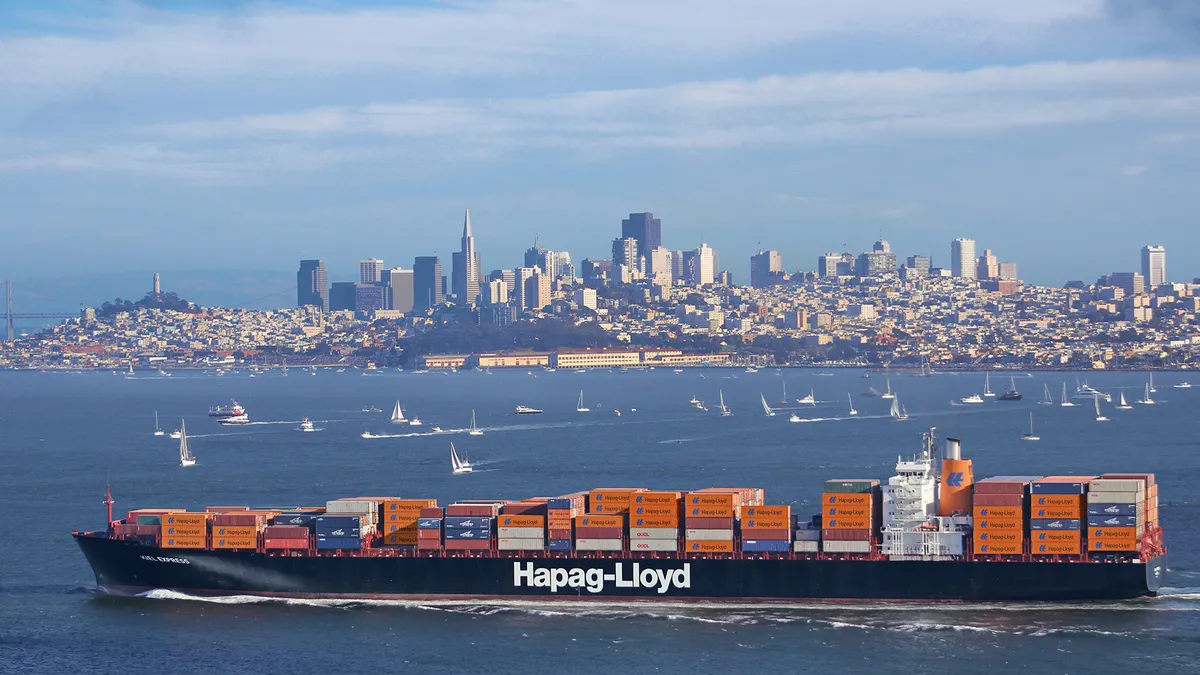Dive Brief:
- Average freight rates at Hapag-Lloyd rose almost 5% year-over-year in the first half of 2019, reaching a rate of $1,071 per TEU amid growing shipment volumes, according to the container line's recent earnings report.
- The higher rates, along with increased shipping volumes, contributed to a "solid first half of 2019," CEO Rolf Habben Jansen said in a statement. Revenue rose 7% from the first half of 2018 to the first half of 2019 when measured in U.S. dollars, according to slides released with its earnings.
- Habben Jansen said the positive results for the German container line mean its outlook for the remainder of the year is unchanged "even if we have to deal with more trade restrictions and see increasing geopolitical risk."
Dive Insight:
Market demand largely dictates ocean freight rates on particular trades. Hapag-Lloyd saw higher transport volumes in the first half of 2019 on Atlantic, Transpacific, Far East, Latin America and EMAO (Europe - Mediterranean - Africa - Oceania) routes, and in turn, higher freight rates and revenue on all of these trades.
While Hapag-Lloyd did not directly state reasons for the increased volume and demand, the Transpacific trade as a whole saw volume spikes in late 2018 and early 2019, coinciding with the timing of tariffs on billions of dollars worth of goods from China.
That rush to import goods led to a "surge in freight rates," according to an analysis from Drewry, leaving U.S. importers paying a premium for shipments to avoid tariffs. Data from Freightos also shows a significant spike in rates globally, beginning around September 2018, when the U.S. announced tariffs on $200 billion worth of goods from China.
With the latest announcement of 10% tariffs on $300 billion of Chinese imports, Drewry anticipates another "brief spike" in Transpacific freight rates this month.
Geopolitics greatly influence global trade demand and can be a large source of risk for container lines that rely on trade flows for business. Hapag-Lloyd's current forecast accounts for the increased tariff rate, from 10% to 25%, on list three ($200 billion of imports from China), along with uncertainties around Brexit. The container line's earnings report did not mention the latest U.S. tariff announcement of 10% tariffs on the remaining $300 billion worth of imports from China.
"The risks listed may have a negative impact on transport volumes, freight rates and costs and consequently have a negative impact on earnings," Hapag-Lloyd said in its report.
Other carriers have expressed similar concerns about the global trade environment. In February, Maersk executives said uncertainty in U.S.-China trade negotiations, Brexit and Europe-U.S. discussions could cause their predictions of 2% volume growth to go awry.
While both carriers are standing by their initial guidance and outlooks, both have also acknowledged the volatility in the market could change the course of ocean freight at any point.
"The existing global macroeconomic uncertainties and ongoing stiff competition could have a significant negative impact on the development of transport volumes and freight rates again in 2019," Hapag-Lloyd said.













